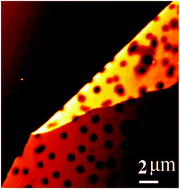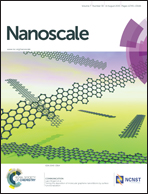Ultrathin, freestanding, stimuli-responsive, porous membranes from polymer hydrogel-brushes†
Abstract
The fabrication of freestanding, sub-100 nm-thick, pH-responsive hydrogel membranes with controlled nano-morphology, based on modified poly(hydroxyethyl methacrylate) (PHEMA) is presented. Polymer hydrogel-brush films were first synthesized by surface-initiated atom transfer radical polymerization (SI-ATRP) and subsequently detached from silicon substrates by UV-induced photo-cleavage of a specially designed linker within the initiator groups. The detachment was also assisted by pH-induced osmotic forces generated within the films in the swollen state. The mechanical properties and morphology of the freestanding films were studied by atomic force microscopy (AFM). Inclusion of nanopores of controlled diameter was accomplished by performing SI-ATRP from initiator-coated surfaces that had previously been patterned with polystyrene nanoparticles. Assembly parameters and particle sizes could be varied, in order to fabricate nanoporous hydrogel-brush membranes with tunable pore coverage and characteristics. Additionally, due to the presence of weak polyacid functions within the hydrogel, the membranes exhibited pH-dependent thickness in water and reversible opening/closing of the pores.


 Please wait while we load your content...
Please wait while we load your content...